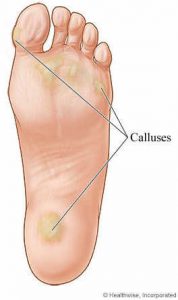
Calluses are thickened, dead tissue involving the outer layer of the skin (epidermis). They are similar to corns, with the difference being their location. Calluses are located on the soles of the feet, particularly the ‘balls,’ while corns are located on the toes.
The primary cause of callus formation, as with corns, is excessive pressure due to the underlying bone. The metatarsal bones, which are the long bones forming the ‘balls’ of the feet, are the most frequent cause of calluses. These metatarsal bones can be long, rotated, enlarged or lowered in relationship to the other metatarsal bones, causing excessive pressure.
Abnormal weight distribution can also cause calluses. This ‘thickened’ tissue is built up out of the natural defense of the body to protect these areas of abnormal pressure. Footwear can aggravate the condition, however, hereditary is the major cause of the bony abnormalities.
Shoes with a thicker cushion sole may be beneficial in absorbing the abnormal pressure. If abnormal weight distribution is the cause of the callus formation, an orthotic can control the pressure across the balls of the feet.
To provide relief from callus pain, the abnormal weight the callused area is carrying must be reduced and re-directed to the rest of the foot. The easiest way to accomplish this goal is with the use of Custom-Made Orthotics. Custom orthotics can both control any abnormal foot motion which is occurring and relieve weight bearing from the painful callus. If you do not have custom orthotics then at least attempt to use an “off the shelf” type of insole for added cushioning. It is often helpful to make a cut-out in the insole directly under the painful callus. Addition of a metatarsal pad placed just proximal to the callus is sometimes helpful. If the calluses are severe enough and very thick you may need to see a podiatrist to trim them down.
Wear shoes with a low heel (about 3/4 to 1 inch high). Wear shoes with thick, well padded innersoles and outer soles, such as walking shoes. Even bedroom slippers should be well padded. Do not walk bare foot. Protect the bottoms of your feet with good shoes. Do not cut or trim them. If you are a diabetic or have poor circulation, check with your family doctor before treating your calluses. Don’t let calluses get too big; they can crack and become infected. To reduce friction when you run, wear thicker socks, such as Thor-Los, which have extra padding in high-friction areas. Watch for blisters that may occur next to thick calluses and treat them appropriately.


